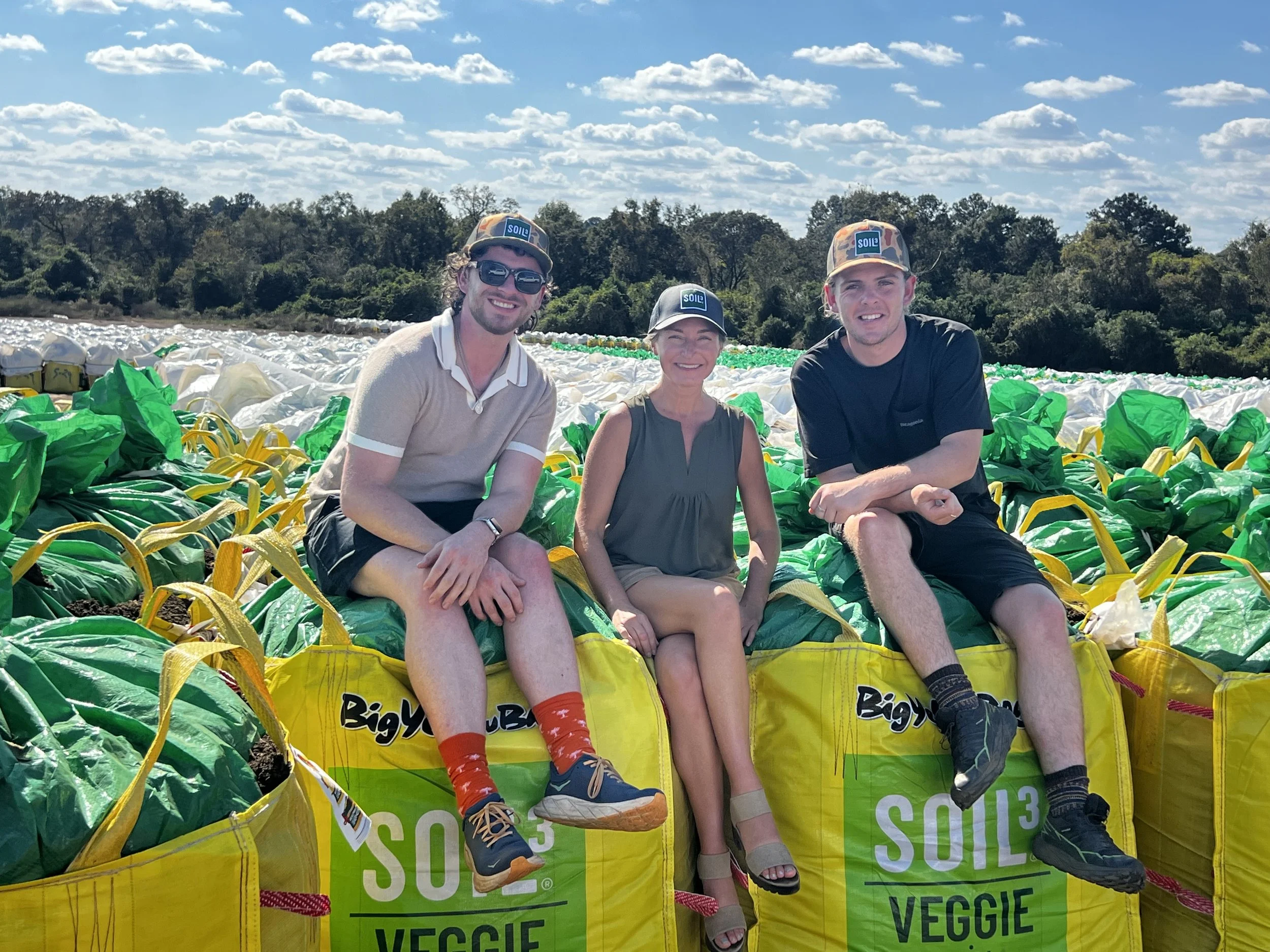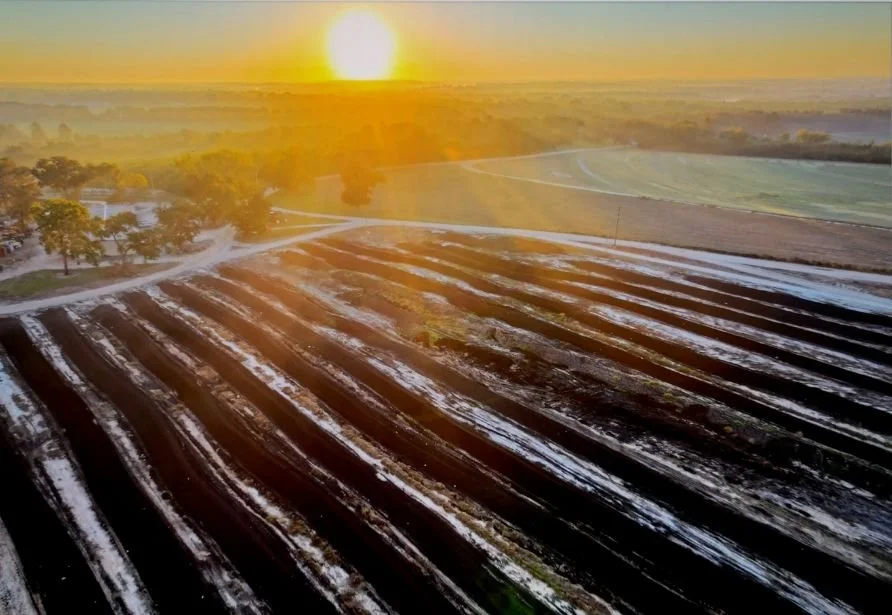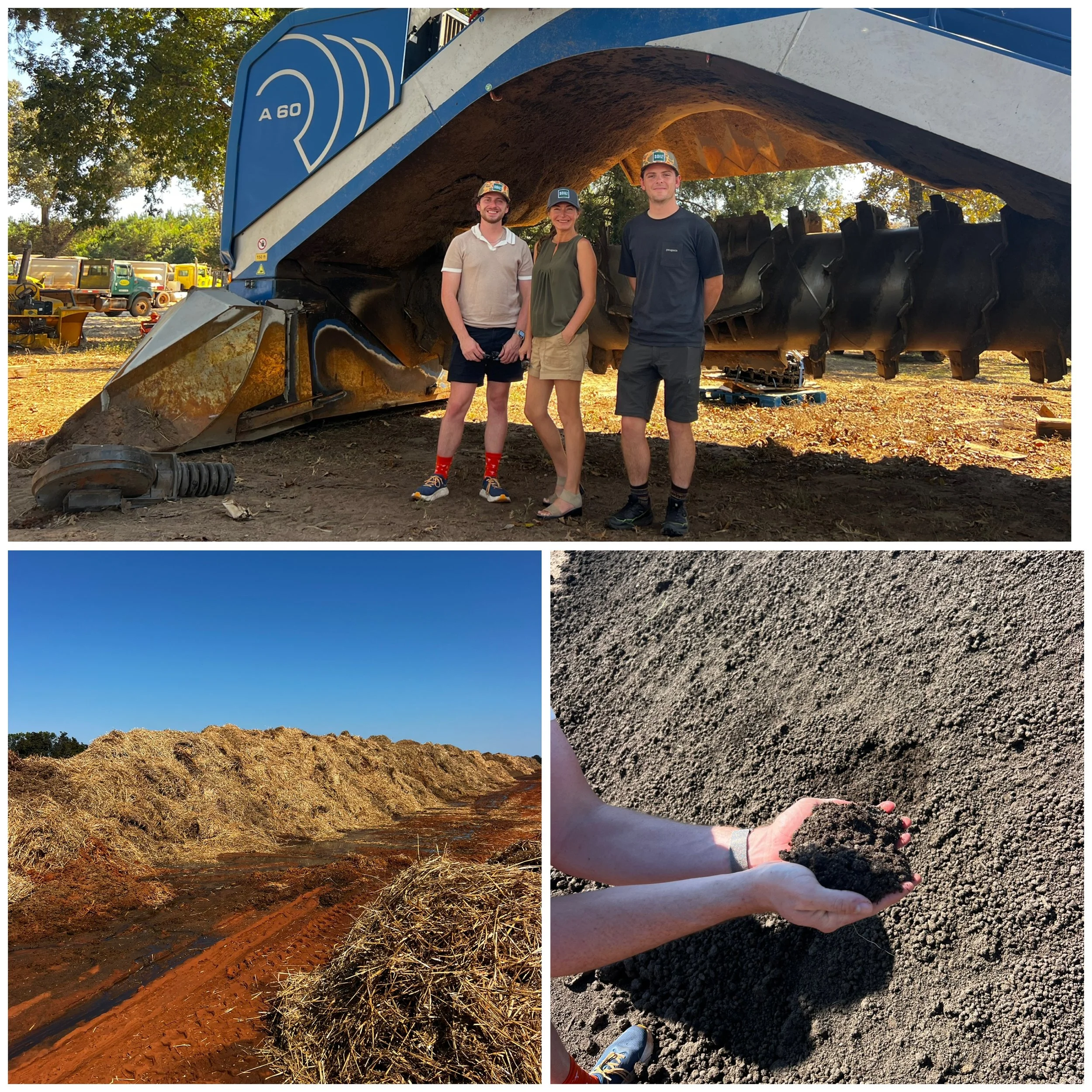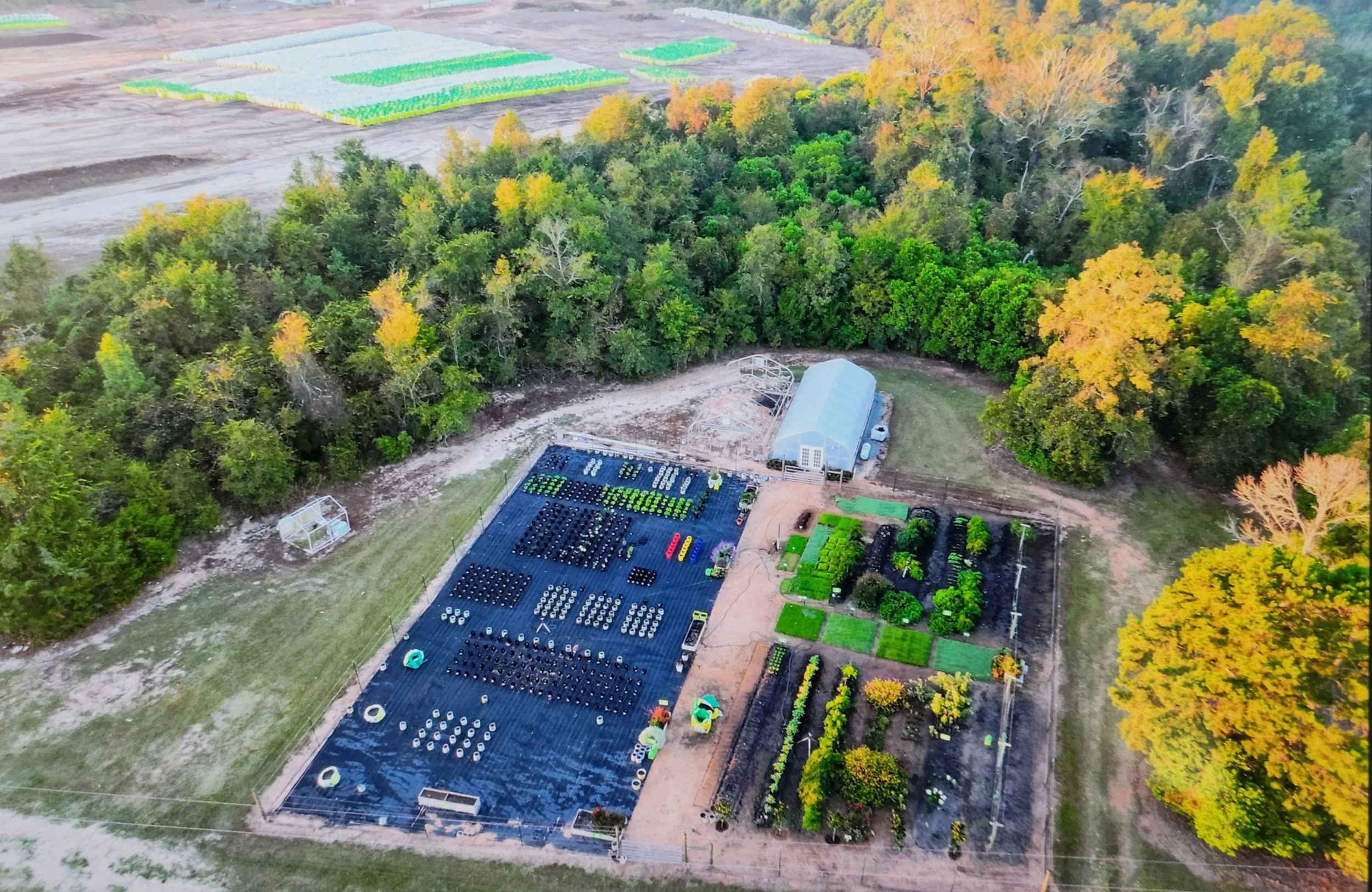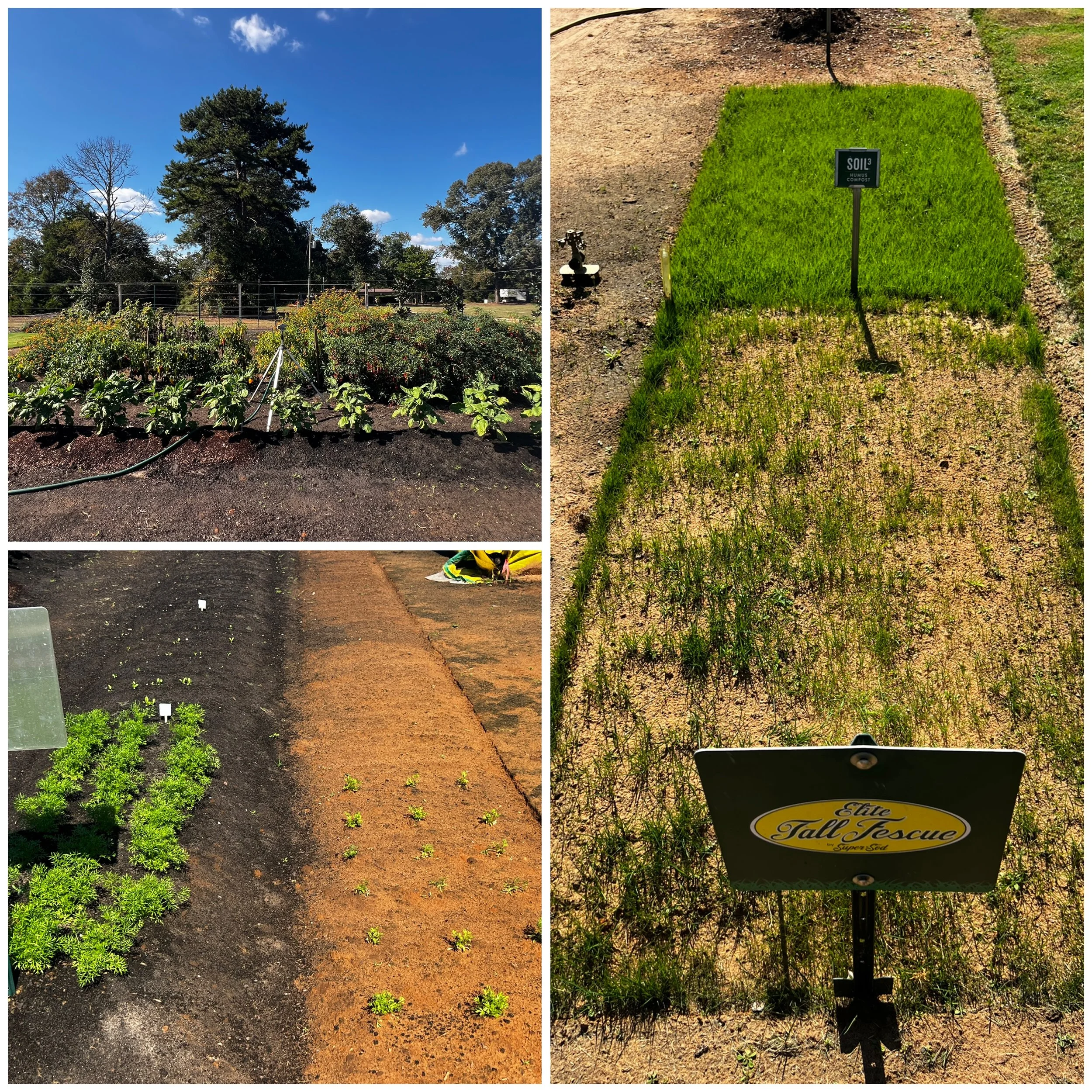A Visit to the Soil³ Compost Farm
Recently I had another chance to visit the Soil³ Compost & Super-Sod Farm in Georgia and share the experience with my young horticulture companions who I travelled with for 2 weeks. Neither of them had ever visited a facility that produced compost on a mass scale, so I knew this stop on our 2,500-mile adventure was going to be special.
Max McKeown (Horticulturist Huntsville Botanical Garden), Brie Arthur, and Josh Taylor (Production Manager Peninsula Growers Melbourne, Australia) posing with freshly bagged Veggie Mix ready to change the lives of gardeners in the southeast!
First Impressions: A Working Landscape
The farm is an impressive blend of innovation, sustainability, and good old-fashioned organic matter. If you’ve ever wondered what it takes to create a premium growing mix from scratch, this visit is a fascinating peek behind the curtain.
Driving onto the farm, you immediately sense the scale and intention of the operation. Long windrows of compost stretch across the landscape, slowly transforming grass clippings, straw, and manure into nutrient-dense humus. Giant turners methodically work through the piles, aerating them for optimal microbial activity.
The windrows are turned weekly to ensure the highest quality compost.
From 3 Raw Ingredients to Soil³ Garden Magic
One of the most fascinating parts of visiting the Soil³ facility is seeing firsthand how their signature composts come to life. This premium humus compost starts with just three raw ingredients: grass clippings, wheat straw, and cow manure from a local dairy. Together, these simple, clean materials create a powerful, nutrient-rich blend that transforms ordinary soil into extraordinary growing media.
That’s right, just three ingredients set Soil³ apart: Grass, Wheat, and Manure. These components are carefully layered into long windrows and turned with state-of-the-art composting equipment. During this process, a small amount of sand naturally mixes in from the windrow pads, which actually improves drainage and soil structure, making the compost even more beneficial for gardeners and growers.
What truly makes Soil³ unique is their control over every input. The team grows most of the grass and wheat themselves and partners with a dairy that feeds its cows silage, ensuring the manure is clean and consistent. Unlike many compost producers who rely on random carbon and nitrogen sources that can be contaminated, Soil³ maintains full transparency about how their compost is made, and that’s something every gardener can feel good about.
Using a high-heat composting process, each batch reaches at least 160ºF for four weeks. This ensures complete decomposition and creates stable, long-lasting humus compost. Beneficial mycorrhizae are added, and natural microorganisms thrive throughout the process, helping plants absorb nutrients and build healthy soil ecosystems. Finally, the compost is finely screened for that signature crumbly texture, never coarse or mulch-like.
Soil³ compost is also approved by the Organic Materials Review Institute (OMRI) as a product for certified organic gardening. Many composts claim the word “organic,” but in reality, are far from it. Check with OMRI to verify the authenticity of claims that any product is safe for organic gardening.
Click the photo below to watch a behind-the-scenes video and see how Soil³ turns three simple ingredients into pure garden magic.
What Makes Veggie Mix Different?
Veggie Mix starts with OMRI-listed Soil³ compost and combines aged pine bark, wood fiber, and activated charcoal, a powerful trio that helps regulate water and bind and neutralize residual pyridine carboxylic acids. Activated charcoal, in particular, acts like a magnet for contaminants, preventing them from being absorbed by plant roots.
Beyond smart formulation, Soil³ takes testing seriously. They perform biological assays, which are field-based tests that measure how living plants respond to the compost. These real-world evaluations allow them to guarantee that their compost is safe, stable, and ready to use.
In short:
🌿 Clean Inputs. They grow and source their own materials responsibly.
🧪 Rigorous Testing. Every batch is verified through bioassays.
🌱 Proven Results. Veggie Mix consistently supports thriving, productive gardens.
I’ve learned the hard way that not all compost is created equal. Soil³’s Veggie Mix gives gardeners peace of mind and plants the healthy foundation they deserve. It’s the product of science, integrity, and a genuine commitment to quality.
The front Lantana ‘Miss Huff’ was planted in the native soil; the rear was planted in Soil³ at the same time! The difference in growth is shocking and proves that using this compost is always the best decision.
What Are Persistent Herbicides?
If you buy compost, chances are you’ve heard of, or unfortunately experienced, a troubling phenomenon known as “Killer Compost.” I fall into the “been there” category, and let me tell you, it’s a sad affair. After watching my own plants wither from contaminated compost that I purchased, I took a crash course in understanding the why behind this issue. What I discovered was a complicated, grey-area problem: in modern agriculture, progress often comes with unintended consequences.
The main culprits are a relatively new class of herbicides called pyridine carboxylic acids, particularly aminopyralids. These selective herbicides are commonly used in agriculture and roadside management to control broadleaf weeds and invasive species.
How Aminopyralids Work
Aminopyralids imitate a plant’s natural growth hormones called auxins. Auxins tell cells when to divide, stretch, and form new tissues. When these herbicides enter a plant, they overload the system with fake auxin signals. It’s like turning a normal growth dial up to “11” and then snapping off the knob.
What Happens Inside the Plant
Once the herbicide is absorbed through leaves or roots:
Cells start dividing uncontrollably, especially in young tissues like shoot tips.
Stems twist and curl, and leaves cup or become strap shaped.
Vascular tissue (xylem and phloem) becomes distorted, so water and nutrients can’t move properly.
Roots become stubby or stop growing, making the plant collapse from starvation.
Eventually, the plant essentially grows itself to death.
Why They Affect Some Plants and Not Others
Aminopyralids specifically target broadleaf plants (like tomatoes, beans, sunflowers, many ornamentals).
Grasses shrug them off because they metabolize the chemical differently and don’t react as strongly to auxin mimicry.
Why Gardeners Care
These herbicides are very persistent. They can survive:
cow and horse digestive systems
composting
winter weather
soil for several years
Which is why contaminated hay, straw, manure, and compost can wipe out broadleaf crops fast. What makes these herbicides especially tricky is their persistence in soil. Unlike glyphosate, which breaks down quickly, aminopyralids have a long half-life, meaning they resist degradation by soil microbes. A single application can provide long-term weed control. But that same durability causes serious problems when these chemicals end up in composted materials.
Even after passing through animals and going through composting, residual aminopyralid can remain potent. When manure or hay contaminated with these herbicides is used to make compost, it can severely damage sensitive crops like tomatoes, potatoes, beans, and other broadleaf vegetables.
For gardeners, it’s devastating to unknowingly bring home contaminated compost and watch healthy plants twist, curl, and fail to thrive. I’ve seen it firsthand and it truly feels like the end of days in the garden.
How Does This Happen?
The contamination doesn’t usually start with compost producers. In many cases, herbicides drift or run off from roadside or utility spraying. The Department of Transportation and energy companies often use aminopyralid under powerlines, at solar farms, and along highways, where it can leach into nearby fields or water sources. Once these compounds enter the agricultural chain through hay, manure, or straw they are nearly impossible to remove without deliberate remediation.
In my opinion, this issue is far more serious than Roundup ever was, yet it gets a fraction of the public attention. There are no viral memes about aminopyralid, but there are thousands of disheartened gardeners with ruined soil and stunted crops.
Why I Love and Trust Soil³ Compost
After more than two decades of gardening and buying compost from suppliers nationwide, I can honestly say that Soil³ stands apart. When their product was affected by aminopyralid contamination several years ago, they didn’t sweep it under the rug. Instead, they partnered with weed scientists across the country to find a real solution, and that’s how Veggie Mix was born.
Standing in front of a mountain of Veggie Mix makes you feel on top of the world!
Why This Visit Matters
The trial space is an impressive demonstration of the dedication Soil³ has for quality control.
As a horticulture professional, my goal is to share genuine, time-tested advice with gardeners across the country and around the world. My only motivation is to uphold integrity in the products I recommend, because trust is everything. That’s why I take the time to thoroughly research and understand every product I endorse, ensuring that what I share is both honest and rooted in real experience.
Special thanks to Chief Soil³ Agronomist Nestor Vela for providing valuable insights into the complexities of the process. I was most impressed by the demonstration beds that he has created showcasing how Veggie Mix performs in raised beds, containers, and in-ground plantings. Seeing these trials firsthand makes it easy to understand why Soil³ composts are better than all the rest!
These side-by-side trials show the power of Soil³ compost.
For gardeners, educators, and growers, understanding how compost is created at scale is incredibly empowering. It reinforces the importance of high-quality organic matter in every garden from home raised beds to professional nursery production.
For me, the visit deepened my appreciation for the science and stewardship behind building a truly healthy growing medium. And it reminded me that great gardens always begin with great soil.
I've been using this compost for nearly a decade, and it has truly changed my life. I am proud to work with Soil³ and hope that you will use my discount code BRIEGROWS25 to save $10 off every BigYellowBag you order online. Give your plants the boost they deserve!


